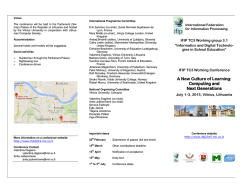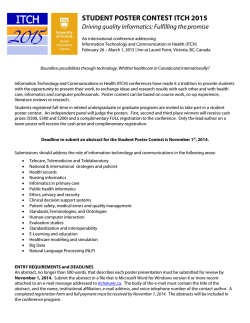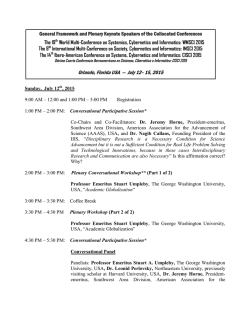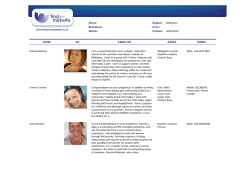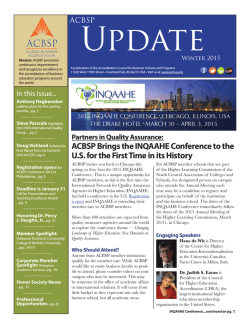
Health informatics and health technology
Health informatics and health technology - an explanatory note 1. Purpose A primary function of the Australian Nursing and Midwifery Accreditation Council (ANMAC) is to ensure that education programs leading to registration and endorsement of nurses and midwives in Australia meet the Nursing and Midwifery Board of Australia approved standards for accreditation. These standards, require program content to support the development and application of knowledge and skills in health informatics and technology. The purpose of this explanatory note is to assist education providers in the preparation and provision of applicable evidence to address the full scope of this criterion in nursing and midwifery education programs leading to registration or endorsement. 2. Background ANMAC is responsible for the accreditation of all nursing and midwifery education providers and programs of study leading to registration and endorsement in Australia. Professional accreditation is part of a broader process of assuring the community that having completed an accredited program of study beginning professional practitioners have achieved agreed professional outcomes and are able to practise in a safe and competent manner equipped with the necessary foundation knowledge, professional attitudes and essentials skills. This explanatory note seeks to guide education providers in addressing health informatics and health technology in nursing and midwifery curricula so that beginning practitioners are appropriately equipped for contemporary practice. Rapid changes and increasing use and reliance upon health informatics and health technology in today’s health care environment has changed the way nurses intervene, access health information and communicate with patients and other care providers enhancing prevention, diagnosis and treatment of illness and health promotion.1 Such pervasive change has led to philosophical discussions around understanding technology within nursing, with some asserting that an opportunity to explore the shared relationship between people and technology means we come to know people more fully.2 According to Barnard, 1 Doswell, W., Braxter, B., deVito Dabbs, A., Nilsen, W., & Klem, M., 2013. Health technology for nursing practice, education and research. Journal of Nursing Education and Practice, 3(10), 99-109. 2 Barnard, A., & Locsin, R. C. (Eds.), 2007. Technology and nursing practice: practice, concepts and issues. Palgrave Macmillan. …nurses are positioned at an axis point between technology, individuals, clinical environments and communities and have a responsibility to take a primary role in interpreting and influencing the relationship(s) between technology, health care praxis and human experience. 3 Individuals who work in or are consumers of the health care system are constantly challenged to access, use and experience ever broadening types of information and technologies. As advocates, nurses and midwives have a responsibility to work with patients and clients in navigating new systems and technology whilst retaining person centred practice and using technology to serve the variables of the human condition, rather than the variables being manipulated to serve technology. Nursing and midwifery education therefore needs to consider, not only technical aspects of health informatics and health technology but also how such technologies impact the lives of those in society and in particular those involved with the health care system. This explanatory note applies to all education providers seeking accreditation of programs of study for nurses and midwives. 3. Application This explanatory note applies to Australian education providers offering programs leading to initial entry or re-entry to the register as a nurse or midwife with AHPRA. 4. Relevant documentation The following documentation is relevant to this explanatory note: • • • • • • • ANMAC Enrolled Nurse Accreditation Standards (2009) ANMAC Registered Nurse Accreditation Standards (2012) ANMAC Midwife Accreditation Standards (2014) ANMAC Enrolled Nurse Application Pack ANMAC Registered Nurse Application Pack ANMAC Midwife Application Pack Australian Qualifications Framework January 2013 5. Explanatory note ANMAC supports in principle innovative approaches to the inclusion of support for the development and application of knowledge and skills in health informatics and health technology in an approved nursing or midwifery program. Health informatics and health technology content in Nursing and Midwifery curricula need to ensure beginning nursing and midwifery practitioners are adequately prepared to use an array of technologies and informatics in nursing and midwifery contexts. To assist education providers this explanatory note will briefly discuss health informatics, health technology and emerging technologies. It will also identify teaching and learning approaches and evidence that can be used to demonstrate the appropriate integration of health informatics and health technology content into nursing and midwifery curricula. 3 Barnard A, 2002. Philosophy of technology and nursing, Nursing Philosophy, 3, pp. 15-26 Health informatics and health technology- an explanatory note. 2 of 5 5.1 Health informatics Health informatics may include work with health information systems, e-health services, electronic health records, clinical decision support systems, telehealth and many other established and emerging uses of information and communications technology in the health professions.4 Nursing informatics can be considered a discipline-specific form of informatics practice within health informatics. In Australia, nursing informatics relates to knowledge and skills required by the registered nurse to integrate nursing science, computer science, and information science to manage and communicate data, information and knowledge in nursing practice. A key element of nursing informatics is information literacy, which includes the effective use of information and communication technology (ICT). 5.2 Health technology The World Health Organisation states ‘health technology refers to the application of organised knowledge and skills in the form of devices, medicines, vaccines, procedures and systems developed to solve a health problem and improve quality of lives.’5 Nurses and midwives are central in the delivery of health technologies and are well placed to participate in health technology assessment - a multidisciplinary process undertaken to evaluate the social, economic, organizational and ethical issues of a health intervention or health technology.6 In preparation for contemporary practice nurses and midwives need to be educationally prepared for safe and competent use of health technologies and be able to critically evaluate their effect on the consumer and the healthcare system. 5.3 Emerging technologies Clearly there are ethical and professional implications in relation to confidentiality, privacy and considerate use of technology such as social media7, blogs, wikis, discussion forums, smart phones and other portable electronic devices. It is important that in the focus on communication in general learning and teaching, the application of issues pertinent to social media are addressed.8 5.4 Learning and teaching A starting point for learning and teaching about heath informatics and technologies is practical application in the academic learning environment. Students gain confidence and appreciation of the possibilities of ICTs through the integration of learning management systems and other e-learning and virtual classroom applications. How to transfer this acquired knowledge and skill to the clinical environment and professional practice should be an important consideration. Additionally, encouraging students to electronically record academic, 4 Whetton, S., 2005. Health Informatics: A socio-technical perspective, Oxford University Press, South Melbourne, p. 260. World Health Organisation, Health topics, Health technology. Viewed at http//www.who.int/topics/technology_medical/en/ on 15 October 2014 5 Australian Government 2009 Review of health technology assessment. Viewed at www.health.gov.au/internet/main/publishing.nsf/Content/AF68234CE9EB8A78CA257BF00018CBEB/$File/hta-review-report.pdf on 15 October 2015. 6 7 Please refer to the Nursing and Midwifery Board of Australia, Social Media policy. Viewed at www.nursingmidwiferyboard.gov.au/Codes-Guidelines-Statements/Codes-Guidelines/Social-media-policy.aspx on October 15 8 Ferguson, C., 2013. It’s time for the nursing profession to leverage social media. Journal of Advanced Nursing 69(4), 745-747. Health informatics and health technology- an explanatory note. 3 of 5 professional and life experiences (e.g. e-portfolio) may facilitate their lifelong learning and continuing professional development. The guiding principle for all learning and teaching strategies related to informatics and technology in health is that being technically competent is a fundamental element of caring. However to achieve this, learning and teaching informatics and technology requires a broader focus than the simple transfer of knowledge. Ideally health informatics and health technology content is embedded across the curriculum incorporating various levels of learning: • Technical level - addresses skills, knowledge and understanding required for professional practice • Contextual level - addresses the application of skills and knowledge to the educational and professional workplace setting • Emancipatory level - addresses the ability to transfer knowledge and skills across contexts and adapt to and use emergent technology, legally and ethically from a person centred perspective. Some examples of how these levels of learning may be applied: Technical level of learning deals with the development of skills. The introduction and use of equipment such as monitors, clinical machinery found in the practice settings, electronic records and e-portfolios might be examples of this level of learning. The introduction to a broad range of uses of technology such as telehealth. Strategies for the development of information literacy. Contextual level of learning applies to the application of such skills and knowledge within a given context. Discussion with students about the use of technology and informatics during professional workplace experiences and the way these technologies impact patient care and have the potential to situate the nurse or midwife as consumer advocate. This level includes the ability to determine appropriate technological intervention, effectively communicate with the multidisciplinary team, and interact and educate patients about the use of technology and the way this might impact upon the person. Emancipatory levels of learning encourage and develop critical thinking skills. This is done by investigating and questioning the assumptions held by the nurse / midwife, organisation or society about the use of informatics and technology. This would include ethical and legal aspects including the use of social media. Health informatics and health technology- an explanatory note. 4 of 5 5.5 Evidence Submissions that appropriately integrate health informatics and health technology content into nursing and midwifery curricula submissions will demonstrate: • Program content and assessment related to information literacy and other elements of health informatics and health technology as described in this explanatory note. • Processes to ensure academic staff have a sound understanding of health informatics and health technologies and engage in ongoing development to facilitate technological knowing and participative engagement. • Processes to ensure students understand how to access professional policies, guidelines and procedures that relate to the use of social media. • Health informatics and health technology resources are sufficient in quantity and quality to support the development of knowledge and skills with an adequate and appropriate future focus. Table of amendments Version number Date Short description of amendment V2 October 2014 Final draft V3 December 2014 SAAC- bullet point addition to Section 5.5 Date of ANMAC Standards, Accreditation and Assessment Committee Determination 8 December 2014 Date for Review 1 February 2016 Responsible Director: Executive Director of Accreditation Services Health informatics and health technology- an explanatory note. 5 of 5
© Copyright 2025
